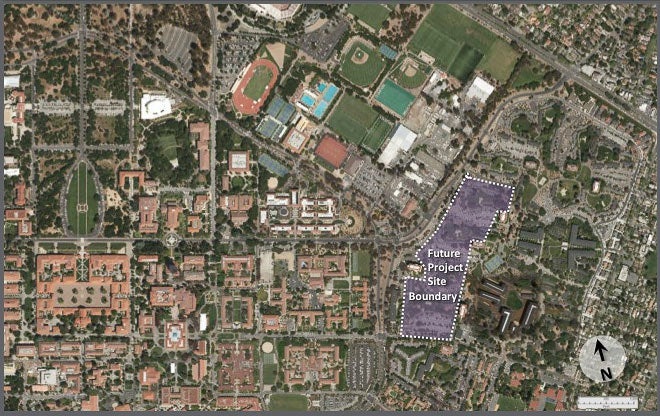
Aerial map shows site of the proposed new graduate housing project in Escondido Village. (Click image to enlarge.) (Image credit: Courtesy Stanford Land Use and Environmental Planning)
Stanford this week will begin the formal application process to pave the way for the university to construct a new 2,400-bed, four-building graduate student residential complex that was first discussed in October.
After several months meeting with members of the graduate student community, Stanford administrators have determined the project site within Escondido Village, as well as its height and density.
“We listened carefully to the feedback we received from throughout campus and changed the proposal in ways that benefit the project and should ease any concerns people have expressed,” said David Lenox, campus architect. “Given how desperately this housing is needed, we are ready to move forward and submit our proposals.”
The university plans this week to seek approvals from Santa Clara County to redistribute the remaining housing allowed under its General Use Permit to the Escondido Village location and to add 1,450 additional beds to the permit.
Once designs for the graduate student residential complex are complete, the university would then apply later this year for the project-specific architectural and site approvals needed to actually construct the project. Pending the design process and county approvals, construction could begin as soon as this fall. Construction will take place over three years, with the new housing possibly available for occupancy in fall 2019.
The project site abuts Serra Street and Campus Drive, running between Thoburn Court and Escondido Road. Also eventually planned in that area is an improved intersection for Campus Drive and Serra Street.
The site allows the university to accommodate graduate student families in a cluster of housing units with courtyards on the north side of Escondido Village between Serra Street and Stanford Avenue. Graduate students concerned about housing conducive to family life were among the constituencies that met with administrators during the past three months.
Increasing Stanford’s capacity to house more graduate students is a critical university need and has become an urgent priority as rapidly rising rents in the Bay Area have created financial stress for many graduate students. Currently, about 5,700 graduate students live in university-provided housing.
The proposed new buildings will be multistory, ranging from six to 10 stories, similar to current building heights in Escondido Village. They will house primarily single graduate students or couples without children. The complex would replace a number of two-story buildings that now house about 400 students, for a net addition of about 2,000 beds.
Initial design concepts for the buildings include premium studio apartments, two-bedroom apartments and junior studios similar to those now offered in the new Kennedy Graduate Residences complex, also located in Escondido Village. Amenities under consideration include a pub/café/market, exercise spaces, cinema, dance studio, group music practice spaces, study rooms and offices for student housing and graduate life professionals.
Also proposed is the construction of underground parking. Alternate transportation options would also be enhanced for the area, building on a trend among graduate students to own fewer cars. Car sharing, bike spaces and additional Marguerite shuttles are some of the options being explored to serve the new residences.
The university will continue to meet with graduate students and others through the planning and design process to seek feedback on the project.
“We greatly appreciate the amount of time and thought that went into the valuable feedback we received from the graduate community during the initial planning stage of this essential new housing project,” said Shirley Everett, senior associate vice provost for Residential & Dining Enterprises. “We look forward to working with graduate students on planning the common space and community amenities, upgrades to the courtyards and play areas, and relocation logistics.”
While the construction is underway, the university proposes to relocate affected graduate students. Single students will be relocated to other Stanford housing, and families will be moved to similar clusters of housing within Escondido Village that surround courtyards important to those with children. Some families will move to upgraded housing east of Mirrielees and close to Bing Nursery School, Pepper Tree House and Escondido Elementary School. There, the university plans to create spaces for child play and family community gathering in that area, plant a landscaped buffer, add playground and sandbox equipment and install low fences to separate small yards from streets.